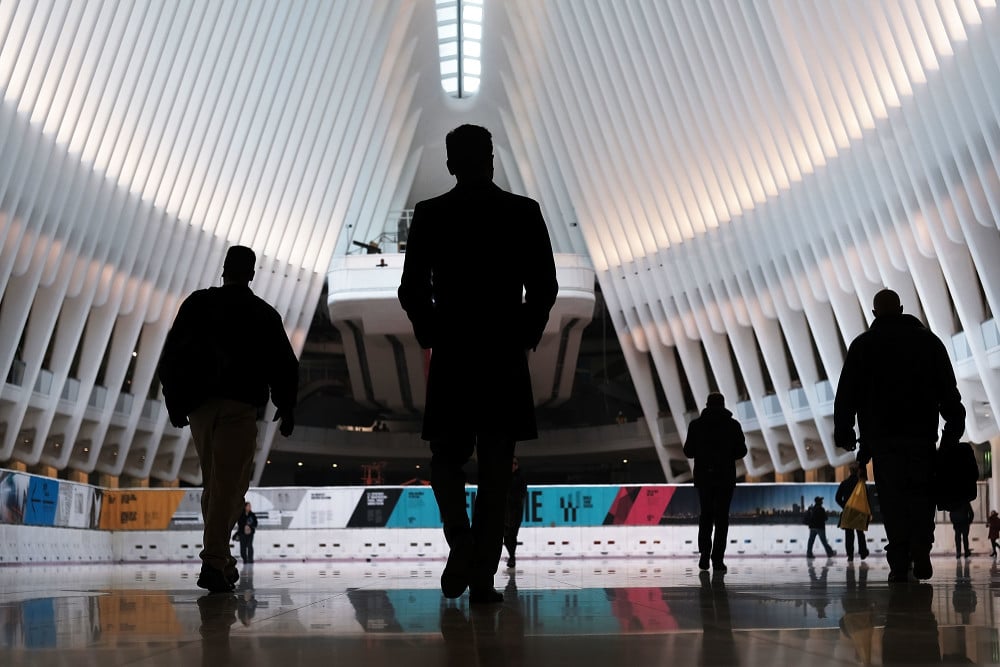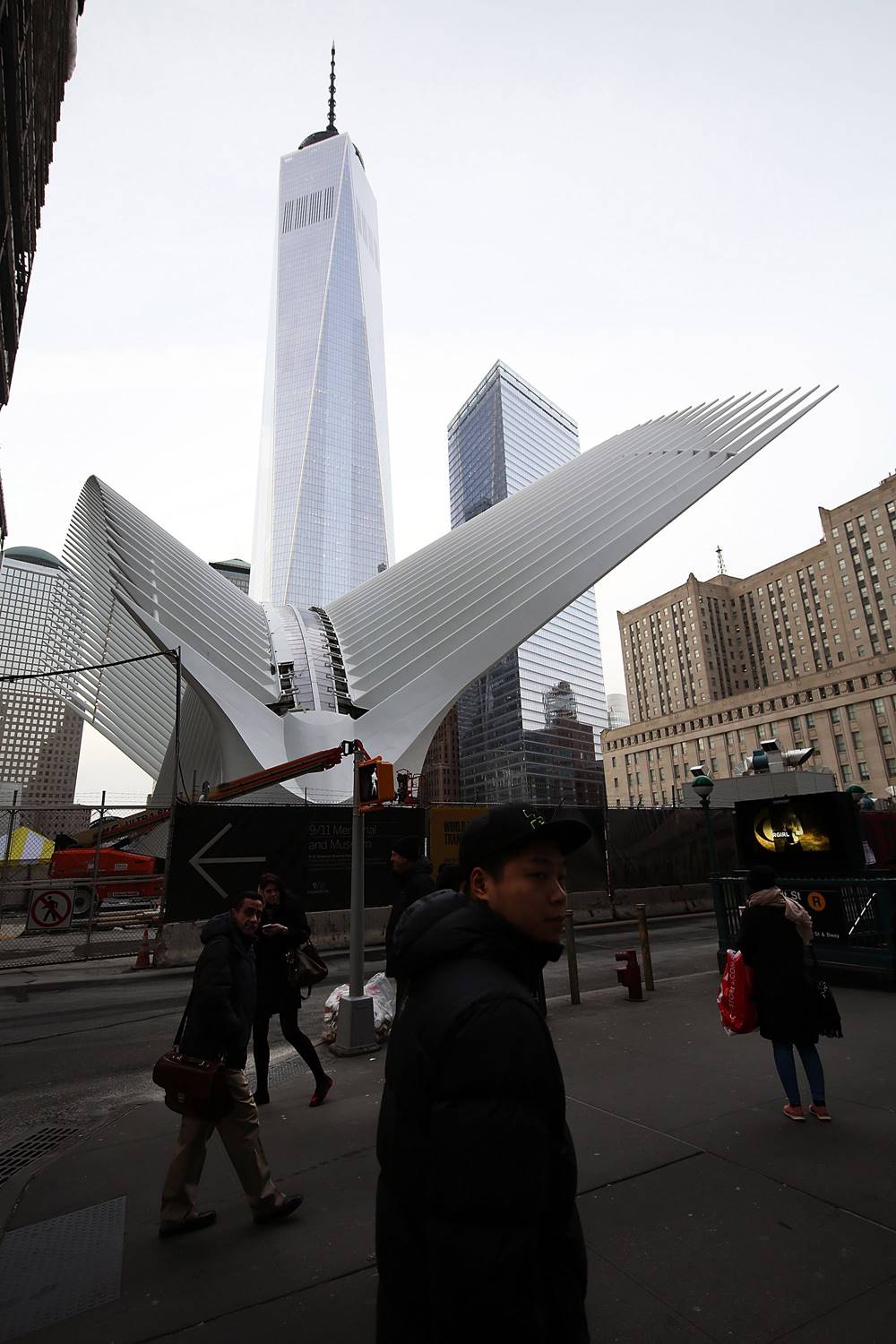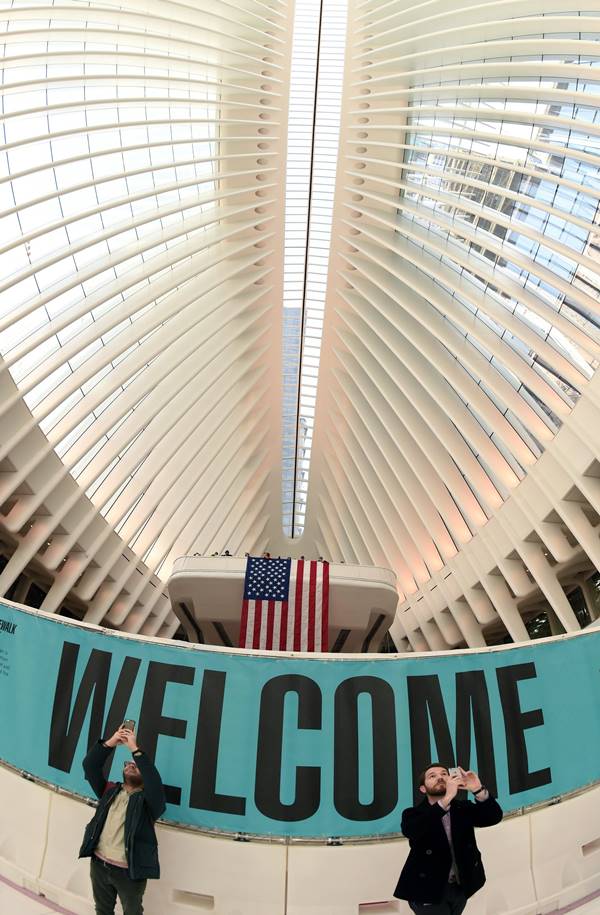Reviews
Santiago Calatrava’s WTC Transport Hub Is a Bloated Trump-Like Turkey
Why the world’s most expensive subway station opened with a whimper.

Photo by Spencer Platt/Getty Images.
Why the world’s most expensive subway station opened with a whimper.

Christian Viveros-Fauné

When the New York Times asked readers what they saw in the dramatic design of the newly inaugurated $4 billion World Trade Center Transportation Hub, folks had no problem being brutally honest. “A turkey carcass the day after Thanksgiving,” said one local. “The Second Avenue Subway, still unbuilt after fifty years,” volunteered another. “I see fares going up to pay for it,” offered a third with a keen grasp of city politics.
Designed by controversial starchitect Santiago Calatrava, the world’s most expensive subway station opened last week at Ground Zero not with the expected Pharaonic bang but with a mosquito-sized whimper. A partial launch intended to drum up support for a much-criticized tri-state construction project and deflect flack from a still-ballooning budget—the original construction estimate was $2 billion—this significant non-event was shunned not once, but three times by city and state officials.
All three top metro executives—the Governors of New York State and New Jersey and the Mayor of New York City—passed on the hub’s aborted inauguration, while outgoing Port Authority Director Pat Foye emphatically shot down the idea of a ribbon cutting ceremony. Why so little respect paid to this colossal public building and Calatrava, the winner of the 2015 European Prize for Architecture?
The scale of the cost overruns is one stated reason; ditto for the claim that money might have been spent on more vital infrastructure (these projects include, among others, Penn Station repairs, the Gateway Tunnel and the elusive Second Avenue train). Foye’s more succinct rationale for shunning the bird-shaped subway stop: “The thing is a symbol of excess.”
Like other massive building projects, the World Trade Center Transportation Hub will eventually come to mean many things to many people. But for now it’s New York’s white-marbled rabbit hole into the decadent world of Calatrava—the builder Fast Company magazine pegged as possibly “the world’s most hated architect.” Slagged publicly by colleagues (Michael Graves’s scathing exclamation “Cala-fucking-trava!” lives on in a widely circulated YouTube video), despised by former clients (he has been included in lawsuits by multiple European municipalities), and reviled in his native Spain for his public budget busting (he cost his hometown of Valencia more than a $1 billion for a group of unfinished buildings), Calatrava has become a catchword for modern architecture’s worst aesthetic and financial abuses.

NEW YORK, NY – MARCH 03: The part of the new partially opened World Trade Center Transportation Hub known as the Oculus sits under the One World Trade building on March 3, 2016 in New York City.
Photo by Spencer Platt/Getty Images.
Here’s just one example of the ire provoked by the architect’s name and wasteful reputation. A watchdog website called Calatravatelaclava, which loosely translates into “Calatravafucksyou,” was shut down a year ago by a Spanish court. Days later, the site was reborn as Calatravanonoscalla, or “Calatravawontshutsusup.”
If Calatrava’s early successes, like his 2001 ship-with-wings addition to the Milwaukee Art Museum, led to his being considered the rightful heir to Frank Gehry’s mantle of world’s most famous architect, his massive screw-ups at home in Spain have become the stuff of legend. Most prominent among these are a local exhibition center that literally fell in on itself in Oviedo, an airport in Bilbao that opened without an arrivals hall, and Valencia’s Palace of the Arts, which after 14 years and 487 million euros has been deemed a public hazard by the local government. And then there’s the “Bridge of the Broken Legs,” as Suzanne Daley in the New York Times calls it. An infamous footbridge over Bilbao’s Nervión River the architect built with a glass tile surface—ignoring the region’s average 128 days of precipitation—it has led to countless accidents that evidently require the city to pay out medical costs when unlucky pedestrians go ass over teakettle.
One of the frequent claims Calatrava’s critics make is that he builds, like the Pharaohs once did, without a thought to the consequences. Considering the architect’s dismal record, one has to concede that they have a point. But the strongest argument against Calatrava’s exorbitant constructions extends out from concerns about municipal planning, public safety and the use of government funds into full-blown aesthetics—especially since Calatrava fancies himself a real artist.
To judge the worth of his structures it’s not enough to say that his expensive bridges, auditoriums, and train stations may fall apart before they are finished. It’s also important to venture that—though they sometimes prove impressively delicate feats of engineering—they increasingly channel the bombastic kitsch of Trump Tower.

Santiago Calatrava’s World Trade Center Transportation Hub, known as the Oculus.
Photo credit: TIMOTHY A. CLARY/AFP/Getty Images.
In this respect, the World Trade Center Transportation Hub can be said to be the mother of all Calatrava boondoggles—and the single most pompous structure built during New York’s Second Gilded Age. A maze of futuristic tunnels that lead to what architecture critic Michael Kimmelman called “a glorified PATH station,” the structure’s center—the Oculus, as Calatrava has christened it—rises some 160 feet into a scrim of steel-ribbed walls supporting a massive skylight. Below sits a vast white marble floor that extends the length of several football fields. Once the eyes have adjusted to the scale of the place and quit singling out the floating dust motes, the space resembles the familiar interior of an Apple store—but supersized.
How can a white marble floor 392 feet long, 144 feet wide and 160 feet high not be momentarily impressive? The answer is that this kind of scale is historically engineered to provoke the same leaden-knee effect certain epic Catholic cathedrals have on the secular joints of most humans. But to say this is only to take note of the obvious. Also worth mentioning is vacuous emptiness of Calatrava’s hangar, unmarred by a single bench, concession or public kiosk. As such, it recalls Albert Speer’s plans for the 700-foot high Volkshalle, the monument Adolf Hitler’s favorite architect planned for his glorious Berlin Prachtstrasse, or Street of Magnificence; and the original design Ayn Rand’s hero Howard Roark proposed for the Manhattan Bank Building—the one that was scrapped by that fictional institution’s nattering nabobs.
Whether it’s the spirit of the historical Speer or the made-up Übermensch of Ayn Rand’s novel The Fountainhead, Calatrava’s vision channels something uncomfortably close to architectural Trumpism, a 21st century Objectivist ideology for winners by winners that, invariably, also aspire to be masters of the universe. This, to speak plainly, is an architectural ideal wherein function caves into form, criticism is a heroic cross to bear, unfettered genius lords it over the little people at whatever cost, and monuments like the transport hub are immune to the normal cost-to-benefit calculus attendant to all other public buildings. If you listen carefully, you can hear Calatrava’s few remaining fans mustering their logic. Here’s one favorable critic’s comment about the Oculus which doubles as an aesthete’s beard for this monstrosity: “The cost of beauty is often high.” Why not just say: “let them eat cake”?
Which brings me to the words of art historian Kenneth Clark: “I wonder if a single thought that has helped forward the human spirit has ever been conceived or written down in an enormous room.”
Though the patrician Clark excused the reading room of the British Museum from his sweeping judgement, he would certainly not give Calatrava’s bloated turkey of a building a pass. We, dear reader, shouldn’t either.